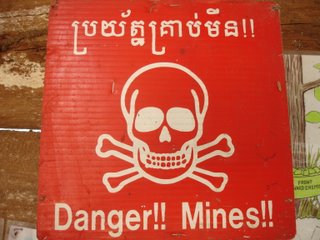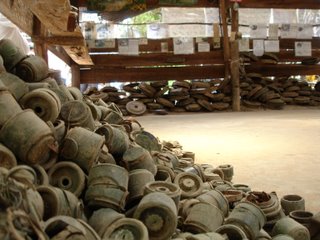Landmine Museum
 The Landmine Museum is a non-government organisation (NGO) set up by a man named Aki Ra in order to increase landmine awareness and provide support and housing for children who have become victims of landmines. There are currently 16 children living at the museum and it provides them with shelter, food and language education. Most became injured whilst working in the fields or playing and many saw friends or loved ones killed in the same explosion.
The Landmine Museum is a non-government organisation (NGO) set up by a man named Aki Ra in order to increase landmine awareness and provide support and housing for children who have become victims of landmines. There are currently 16 children living at the museum and it provides them with shelter, food and language education. Most became injured whilst working in the fields or playing and many saw friends or loved ones killed in the same explosion.Aki Ra, was actually a child soldier of the Khmer Rouge and along with many other children was brainwashed into believing destruction of human life was part of a normal existence. At the age of 10 he was given his first gun, an AK-47 and from then he learned how to plant landmines and other weaponry in the countryside and jungle regions. Captured by the Vietnamese, he then began to fight back against the Khmer Rouge regime and began hid life-long project to rid Cambodia of landmines.
 When not at the museum, Aki spends his time deactivating unexploded ordinance (UXO) or destroying them in controlled explosions. His equipment is worryingly unsophisticated and often uses only a wooden stick and his foot for feeling his way through dense jungle to locate mines! Other members of his team use metal detectors but it's generally hands-on work. UXO can remain active for upto 150 years and the evidence of the destruction they can cause is evident on every street in Cambodia by the startling number of people who have lost at least one limb.
When not at the museum, Aki spends his time deactivating unexploded ordinance (UXO) or destroying them in controlled explosions. His equipment is worryingly unsophisticated and often uses only a wooden stick and his foot for feeling his way through dense jungle to locate mines! Other members of his team use metal detectors but it's generally hands-on work. UXO can remain active for upto 150 years and the evidence of the destruction they can cause is evident on every street in Cambodia by the startling number of people who have lost at least one limb.The variety of UXO is very sophisticated and are designed either to kill upto 20 people at a time or to maim in very specific ways. Some aim for one or two limbs to be amputated, others such as the "Bouncing Betty" to jump in the air and decapitate. Often, UXO contain hundreds of ballbearings which are spewed at the point of detonation, killing or maiming for meters around.
There detailed were "cigarette bombs" whereby a ballbearing is placed halfway down a cigarette, causing the head of the victim to be blown apart on ignition of the TNT component. Gruesome stuff. Others included the "Pineapple Mine" a very deadly method of distributing hundreds of pieces of shrapnel into the air, and anti-tank massive weaponry. The mines are triggered to detonate either by pressure being exerted on it, or by means of a trip wire. We were assured that all the mines at the museum weren't live, but it was still quite unnerving wandering around on dead mines set into the dirt as "decoration!"
Can't quite remember the specifics, but I think 80 people are killed each year in Cambodia as a result of UXO. This doesn't include those injured or maimed and despite mine awareness and clearance programmes, this number is actually increasing rather than decreasing due to the amount of new land being used for agriculture. The devastation spreads far and wide - not only are individuals affected, but families loose breadwinners and they are often forced into begging around tourist areas - especially Siem Reap. On a larger scale, the whole infrastructure of the country continues to be negatively affected, years on from American and Khmer Rouge activity. It is thought that perhaps 7 or 8 million UXO remain in the country - especially around the Thai border and we are always reminded to stick to clearly marked paths. Difficult when you are desperately looking for a sneaky outdoors toilet...

2 Comments:
Yes, lots of ordnance been dropped in Cambodia by all accounts... : (
LOL again +++
Post a Comment
Subscribe to Post Comments [Atom]
<< Home